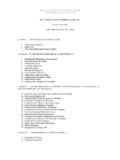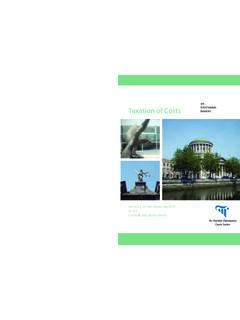Transcription of The Law of Costs – A Brief Overview
1 The Law of Costs A Brief Overview Jonathan de Vries Shillingtons LLP Introduction In the preamble to a 2002 decision on the issue of Costs , a judge of the superior court of Justice commented that as with all matters in litigation, when the outstanding issues are decided, all that is left is the issue of Costs . In the French language the bill is aptly referred to as "la douleur" the "pain". 1 There can be no doubt that this sentiment has been shared by many a litigant. It is a simple fact that litigation is expensive, and has been for a long time. This is well illustrated by the fascinating if perhaps depressing story of Richard of Anesty, a 12th-century English knight who decided to seek the King s justice with respect to his claim of hereditary entitlement to certain lands currently in the hands of a rival.
2 What followed was five years of continuous litigation conducted under a system of civil procedure that often required plaintiffs to, quite literally, follow their suit in person. Anesty eventually won his case, got his land, and lost a fortune in the What makes Anesty s story interesting is that fact that he actually chronicled the litigation in a journal which has come down to us through history. Despite the length and complexity of the litigation, as well as the caliber of Anesty s legal team his entourage 1 Lammie v. Belair Insurance Co.
3 , [2002] No. 4732 at para. 2 ( ) (QL) [emphasis in original]. 2 Frederick Pollock & Frederic Maitland, The History of English Law Before the Time of Edward I, 2nd ed. (Cambridge: The University Press, 1898) at 158-59. Pollock & Maitland provide a short summary of Anesty s litigation: He was claiming as heir to his uncle certain lands of which Mabel of Francheville, who he asserted to be illegitimate, was in possession. He had to begin by sending to Normandy for the king s writ; soon after he had to send for another writ directed to the archbishop, since the question of bastardy would be transmitted to the ecclesiastical court .
4 The litigation in spiritual form was tedious; he was adjourned from place to place, from month to month. The king summoned the army for the expedition to Toulouse; Richard had to go as far as Gascony for yet another royal writ bidding the archbishop proceed despite the war. The litigation went on for another year, during which he appeared in the archbishop s court on some ten different occasions. Once more he had to visit France, for he required the king s licence for an appeal to the pope. He sent his clerks to Rome and the pope appointed judges delegate.
5 Then his adversary appealed, and again he had to send representatives to Rome. At length the Pope decided in his favour. Thereupon the case came back to the royal court and week after week he had to follow it. The king appointed two justices to hear his cause, and at length by the king s grace and the judge of the king s court he obtained the wishes for land. 2of friends and helpers and pleaders evidently included some of the more pre-eminent legal minds of his day3 Anesty s recollections contribute little to either law or legal history. Instead, they focus almost exclusively on the one issue that was clearly at the forefront of Anesty s mind: his Costs .
6 In excruciating detail, Anesty notes the various payments made, horses lost, loans taken out and interest rates As is likely just as true of modern-day litigants, when the question of ultimate success or failure on the merits was left aside, Anesty was concerned less with the contribution his litigation would make to jurisprudence and more with how much he was spending to see the end of it. Given the expenses involved, it should come as little surprise that the law s attention would be drawn eventually to the question of the Costs incurred in enforcing legal rights and who should ultimately be responsible for them.
7 While the law of Costs has perhaps not stood out as a significant topic for legal historians, Costs and Costs jurisprudence would likely have been of just as much interest to early lawyers and litigants as they are to their present-day The History of Costs The concept of awarding a litigant an amount to compensate him or her for their Costs incurred was introduced into English law relatively early. Historically, common law courts had no inherent jurisdiction with respect to awarding Costs , thus leaving Costs as an exclusively statutory The traditional starting point for the history of the law of Costs is the Statute of Gloucester, enacted by King Edward I in 1278.
8 It provided that a 3 Ibid. at 164 and 214. 4 An early translation of Anesty s journal is found in Francis Palgrave, The Rise and Progress of the English Commonwealth (1832). Palgrave concedes that Anesty s ultimate success in his litigation likely had less to do with the merits of his position or the quality of his representation, but was more likely the product of institutional bias in his favour, his personal connections and influence and the strategic use of disbursements that do not have modern equivalents in Part II of Tariff A.
9 5 Arthur Goodhart, Costs (1929) 38 Yale 849 at 852. Aside from some other interesting pieces of historical trivia related to the law of Costs , Goodhart notes that a 1793 edition of Hullock s The Law of Costs lists over a thousand references in the table of cases. 6 Mark Orkin, The Law of Costs , 2nd ed. looseleaf (Aurora: Canada Law Book, 1987) at 1-1; John Baker, The Oxford History of the Laws of England, (Oxford: Oxford University Press, 2003) vol. 7 at 376. But see Pollock & Maitland, supra note 2 at 597; William Blackstone, Commentaries on the Laws of England (Oxford: Clarendon Press, 1765) vol.
10 3 at 399. Several early legal historians have suggested that prior to the statutory rights of Costs recovery, plaintiffs were recovering their Costs on a regular basis simply by having them subsumed into their claims for damages. 3jury could award Costs as part of an award of damages to a successful Subsequent statutes further expanded this entitlement, although the right to cost recovery was by no means comprehensive. Aside from a handful of exceptions, no Costs were recoverable in an action other than one for damages. Also, Costs were not recoverable where an action was ended by means other than a A further and more substantial gap in the nascent law of Costs also remained: the absence of any provision for a defendant to recover Costs .







